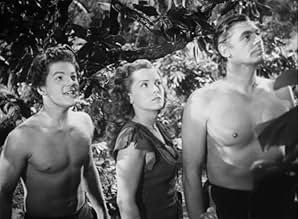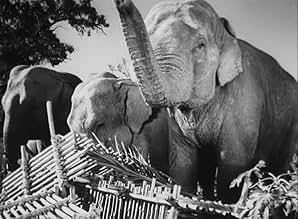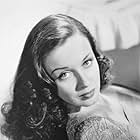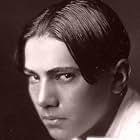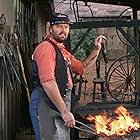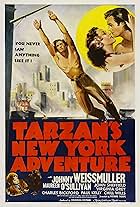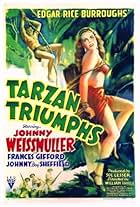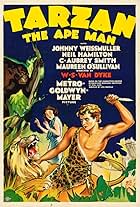IMDb RATING
6.0/10
2.3K
YOUR RATING
To equip the American zoos with as many animals as possible, a cruel trio of big game hunters team up with an unexpected ally, threatening the African fauna. Will Tarzan allow the fiendish h... Read allTo equip the American zoos with as many animals as possible, a cruel trio of big game hunters team up with an unexpected ally, threatening the African fauna. Will Tarzan allow the fiendish huntress to pillage the jungle?To equip the American zoos with as many animals as possible, a cruel trio of big game hunters team up with an unexpected ally, threatening the African fauna. Will Tarzan allow the fiendish huntress to pillage the jungle?
Barton MacLane
- Paul Weir
- (as Barton Maclane)
George Magrill
- Native Guard
- (uncredited)
Georges Renavent
- Man Weighing King
- (uncredited)
Mickey Simpson
- Monak
- (uncredited)
Maurice Tauzin
- Prince Suli
- (uncredited)
- Director
- Writers
- All cast & crew
- Production, box office & more at IMDbPro
Storyline
Did you know
- TriviaIn Tarzan and the Huntress (1947), Johnny Weissmuller in his 11th outing and next-to-lasting outing as Tarzan. Brenda Joyce makes the third of five appearances as Jane, and Johnny Sheffield marks his eighth and final appearance as Boy. The director Kurt Neumann helms the third of his four pairings with Tarzan.
- GoofsWhat's become the necessary intro shot of forest deer overlooking the water appear here again, this time watching Tarzan et co on a raft; deer are not native to Africa.
- ConnectionsFollowed by Tarzan and the Mermaids (1948)
Featured review
Edgar Rice Burrough's TARZAN AND THE HUNTRESS (RKO Radio, 1947), directed by Kurt Neumann, being Johnny Weissmuller's 11th portrayal as the king of the jungle, and fifth under Sol Lesser's unit distributed by RKO, can be summed up by this time in saying, "If you've seen one Tarzan movie, you've seen them all," however the series continues.
The plot revolves around a zoological expedition headed by Tanya Rollins (Patricia Morison) and her guide, John Weire (Barton MacLane) who make arrangements with Prince Ozira (Ted Hecht), nephew of King Farrod (Charles Trowbridge) to capture wild animals for the zoos. After arranging for the death of the king, leaving Prince Suli (Maurice Tauzen) in charge command of the throne, Tarzan (Johnny Weissmuller), having learned of the capture of his animal friends, including Cheta, starts to oppose the expedition and intervene.
Brenda Joyce in her third go round as the blonde Jane, and Johnny Sheffield in his eighth time playing Boy, each continue their recurring roles in the usual manner. This was to be the teen-aged Sheffield's farewell performance as Boy, now being more physically muscular and nearly as tall as Weissmuller's Tarzan, giving full indication that while the writers kept him on as long as possible, he has outgrown his part. Hence, in one scene where Boy wanting to make amends for the wrong he has done, is complimented by his jungle warlord father by telling him, "Boy man now." Indeed he's now a man. Being omitted in the next and all future installments, other jungle boys would be introduced as a replacement to Sheffield's Boy, but never seen on a regular basis. Sheffield was the only young actor whose character was consistent. He would return to the jungle in the character of "Bomba, the Jungle Boy" a new film series as produced by Monogram Pictures (1949-1955). Bomba could very well be Boy returning to Africa after a few years attending school in England, thus, starting life anew and following the tradition of jungle living amongst the animals and facing every day danger like Tarzan. As with the Tarzan/Weissmuller adventures, the writers of the "Bomba" series failed to introduce the jungle boy's origin as to where he came from, who were his people and how did he end up in the jungle. He was already roaming the jungle holding his sphere awaiting for something to happen. Anyway, that's entirely irrelevant to the story department and movie making at that time. Now back to TARZAN AND THE HUNTRESS.
Others appearing in the cast include John Warburton as Carl Morley; Wallace Scott as Smithers; and Mickey Simpson as Monak. And of course there's Cheta, the chimp, hogging many of the scenes, and trying to help out her animal friends from captivity. It's not Tarzan, Jane nor Boy who get to appear in the final fadeout, but Cheta being parachuted from the airplane with the "The End" inter-title superimposed over her puss having the time of her life.
TARZAN AND THE HUNTRESS returns Barton MacLane to the series, once more playing the villain, having already appeared two years earlier in TARZAN AND THE AMAZONS (1945), by whose presence in these two movies could stir up confusion. It would be impossible for MacLane to reprise his original role since his character has met his demise by falling victim to sinking in quicksand. An interesting switch from previous episodes is having a safari leader portrayed by a woman, the role awarded to Patricia Morison, who makes a fine villainous in the most sultry manner. Unlike the previous efforts made for RKO, "Huntress" gets plenty of use of animal extras along with an climatic elephant stampede.
TARZAN AND THE HUNTRESS, clocked at 77 minutes, is acceptable fun but a far cry from being the best in the series. It was one of the many movies from the "Tarzan" package to be presented on the America Movie Classics cable channel (1997-2000) before shifting over to Turner Classic Movies (TCM premiere: June 18, 2011). As much as to where this annual series was heading, the Tarzan adventures continued to hold their own as one of the most popular film series ever produced, enjoyed by many, especially youngsters in the Saturday afternoon matinée crowd cheering on the jungle hero as he battles against the bad guys entering his domain once again. Next installment, TARZAN AND THE MERMAIDS (1948) (*1/2).
The plot revolves around a zoological expedition headed by Tanya Rollins (Patricia Morison) and her guide, John Weire (Barton MacLane) who make arrangements with Prince Ozira (Ted Hecht), nephew of King Farrod (Charles Trowbridge) to capture wild animals for the zoos. After arranging for the death of the king, leaving Prince Suli (Maurice Tauzen) in charge command of the throne, Tarzan (Johnny Weissmuller), having learned of the capture of his animal friends, including Cheta, starts to oppose the expedition and intervene.
Brenda Joyce in her third go round as the blonde Jane, and Johnny Sheffield in his eighth time playing Boy, each continue their recurring roles in the usual manner. This was to be the teen-aged Sheffield's farewell performance as Boy, now being more physically muscular and nearly as tall as Weissmuller's Tarzan, giving full indication that while the writers kept him on as long as possible, he has outgrown his part. Hence, in one scene where Boy wanting to make amends for the wrong he has done, is complimented by his jungle warlord father by telling him, "Boy man now." Indeed he's now a man. Being omitted in the next and all future installments, other jungle boys would be introduced as a replacement to Sheffield's Boy, but never seen on a regular basis. Sheffield was the only young actor whose character was consistent. He would return to the jungle in the character of "Bomba, the Jungle Boy" a new film series as produced by Monogram Pictures (1949-1955). Bomba could very well be Boy returning to Africa after a few years attending school in England, thus, starting life anew and following the tradition of jungle living amongst the animals and facing every day danger like Tarzan. As with the Tarzan/Weissmuller adventures, the writers of the "Bomba" series failed to introduce the jungle boy's origin as to where he came from, who were his people and how did he end up in the jungle. He was already roaming the jungle holding his sphere awaiting for something to happen. Anyway, that's entirely irrelevant to the story department and movie making at that time. Now back to TARZAN AND THE HUNTRESS.
Others appearing in the cast include John Warburton as Carl Morley; Wallace Scott as Smithers; and Mickey Simpson as Monak. And of course there's Cheta, the chimp, hogging many of the scenes, and trying to help out her animal friends from captivity. It's not Tarzan, Jane nor Boy who get to appear in the final fadeout, but Cheta being parachuted from the airplane with the "The End" inter-title superimposed over her puss having the time of her life.
TARZAN AND THE HUNTRESS returns Barton MacLane to the series, once more playing the villain, having already appeared two years earlier in TARZAN AND THE AMAZONS (1945), by whose presence in these two movies could stir up confusion. It would be impossible for MacLane to reprise his original role since his character has met his demise by falling victim to sinking in quicksand. An interesting switch from previous episodes is having a safari leader portrayed by a woman, the role awarded to Patricia Morison, who makes a fine villainous in the most sultry manner. Unlike the previous efforts made for RKO, "Huntress" gets plenty of use of animal extras along with an climatic elephant stampede.
TARZAN AND THE HUNTRESS, clocked at 77 minutes, is acceptable fun but a far cry from being the best in the series. It was one of the many movies from the "Tarzan" package to be presented on the America Movie Classics cable channel (1997-2000) before shifting over to Turner Classic Movies (TCM premiere: June 18, 2011). As much as to where this annual series was heading, the Tarzan adventures continued to hold their own as one of the most popular film series ever produced, enjoyed by many, especially youngsters in the Saturday afternoon matinée crowd cheering on the jungle hero as he battles against the bad guys entering his domain once again. Next installment, TARZAN AND THE MERMAIDS (1948) (*1/2).
- How long is Tarzan and the Huntress?Powered by Alexa
Details
- Release date
- Country of origin
- Language
- Also known as
- Tarzan wird gejagt
- Filming locations
- Production company
- See more company credits at IMDbPro
- Runtime1 hour 12 minutes
- Color
- Aspect ratio
- 1.37 : 1
Contribute to this page
Suggest an edit or add missing content

Top Gap
By what name was Tarzan and the Huntress (1947) officially released in India in English?
Answer



